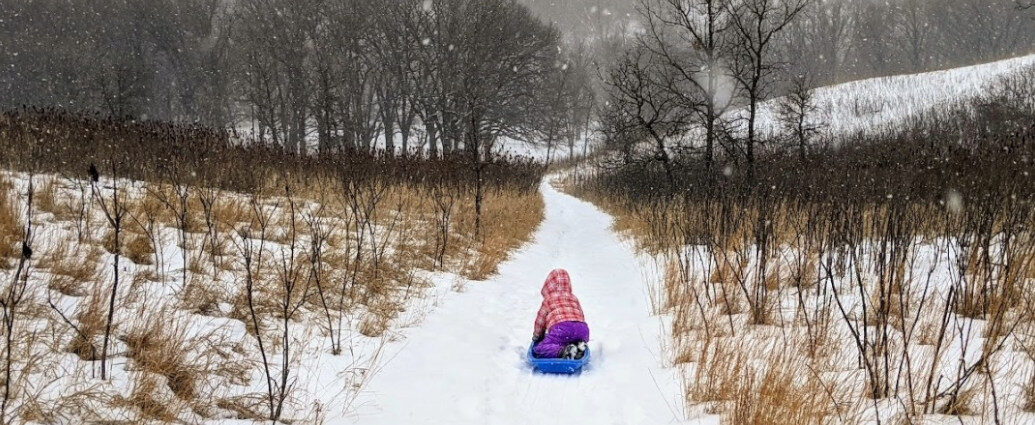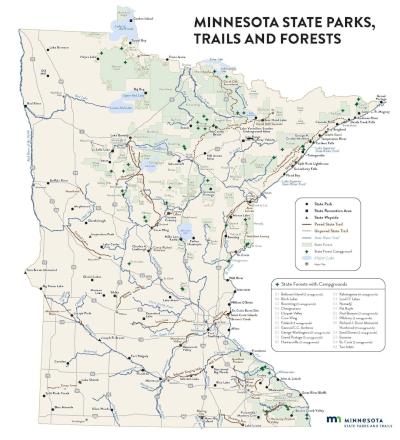 Planning your visit can be overwhelming, especially when you have beautiful state parks and recreation areas in every corner of the state to choose from! That’s why we’ve pulled together some trip ideas with our itineraries. Whether you want to go for a day or a long weekend, these itineraries are a great starting point for planning your next adventure!
Planning your visit can be overwhelming, especially when you have beautiful state parks and recreation areas in every corner of the state to choose from! That’s why we’ve pulled together some trip ideas with our itineraries. Whether you want to go for a day or a long weekend, these itineraries are a great starting point for planning your next adventure!
Before You go
- Be sure to reserve your spot before you go!
- Purchase a vehicle permit today and get a year of unlimited visits to all of Minnesota’s state parks and recreation areas.
- Check out our packing tips before you go to make sure you don’t forget anything
- Build your own itinerary with the Explore Minnesota website
- Find a park near you if you want to go for an afternoon outing
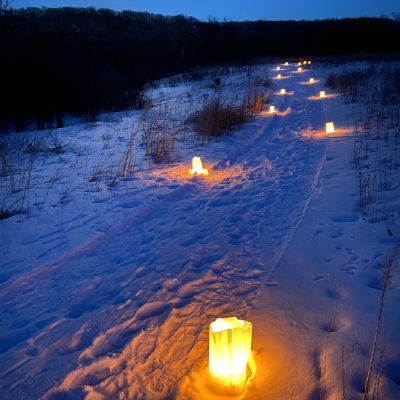
Itasca State Park
Spend a winter weekend exploring Itasca State Park.
- Visit the headwaters of the Mississippi River State Water Trail.
- Check the park’s events calendar to schedule your visit around a candlelight event, guided walk or naturalist program.
- Check the latest snow depth and trail conditions report online.
- In winter, the south entrance is closed. The east entrance and the north entrance remain open.
Day One: Morning
- Stop at the Jacob V. Brower Visitor Center. Pick up a map and get an update on trail conditions or recent wildlife sightings.
- Have lunch.
- Pack a snack and water for your afternoon adventure.
Note: There are no restaurants open in the park in the winter. Vending machines are available in the Jacob V. Brower Visitor Center.
Day One: Afternoon
- Attend a naturalist program
- Hit the trails for a hike, snowshoeing or cross-country skiing under the towering pines. Bring your own equipment or rent snowshoes at the Jacob V. Brower Visitor Center.
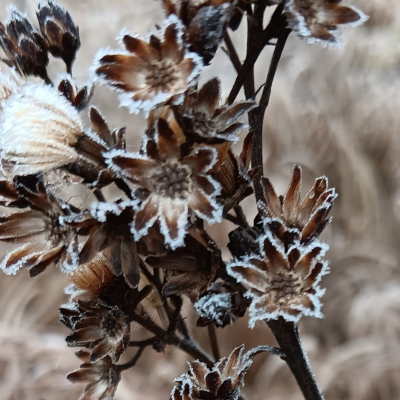 Hiking and snowshoeing at Itasca State Park
Hiking and snowshoeing at Itasca State Park
- Popular snowshoe routes include the Dr. Roberts, Brower and Schoolcraft trails.
- You can snowshoe anywhere in the park except on groomed ski or snowmobile trails.
- A popular and easy ski trail goes from the Jacob V. Brower Visitor Center toward Preachers Grove. Tip: Wear warm winter boots with a flat heel when snowshoeing.
Cross-country skiing. - Miles of groomed trail allow you to choose one that fits your skill, physical condition and the weather.
- The park grooms trails for both classic and skate skiing. Note: Itasca State Park does not rent skis.
- Skiers age 16 and older must carry a signed ski pass on all groomed state park ski trails. Daily passes are available for sale at the Jacob V. Brower Visitor Center.
Warm up
- Warm up in the Jacob V. Brower Visitor Center in front of the fireplace.
- Wander through the building to view exhibits and watch a short movie about the park.
Day One: Evening
- Head back to the Four-Season Suites and make dinner.
- Attend a naturalist-led program or event, if one is offered. If not, play cards or games.
- Take a short evening hike to gaze at the moon and stars. The best views of the night sky can be found along Lake Itasca and in parking lots, such as the one at the Mary Gibbs Mississippi Headwaters Center.
Day Two: Morning
- Have breakfast. Pack a snack and water for the trail.
- Drive to the Mary Gibbs Center at the Headwaters of the Mississippi River State Water Trail. Walk through the outdoor exhibits and down to the water. Note: The nature store and café are not open in the winter.
- Take family photos and selfies in front of the iconic post.
- From the headwaters, walk or snowshoe the Schoolcraft Trail for a wide view of Lake Itasca and Schoolcraft Island.
- Enjoy your snack at the overlook.
- Drink plenty of water to stay hydrated.
- Some of the many animals you may see or hear if you are quiet: owls, woodpeckers, otters, white-tailed deer, snowshoe hare, and mink.
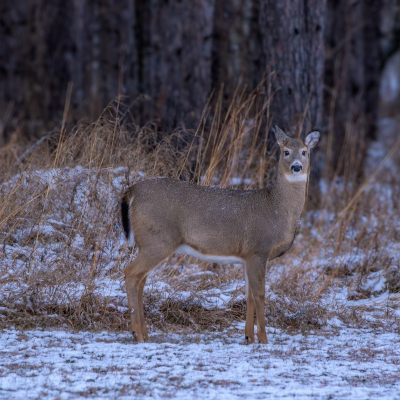 Day Two: Afternoon
Day Two: Afternoon
- Return to your vehicle. It’s time to check out and head home.
Special notes
- Don’t rely on your smartphone for navigation. Cell phones work at the Jacob V. Brower Visitor Center (where there is also wifi), but not in the park’s more remote places.
- Bring a trail map and tell someone where you are headed and when you expect to return.
- Bring warm winter clothing, including good boots, hats, mittens, snow pants, and coats.
- Know and respect your physical limitations when skiing or snowshoeing.
- Stay hydrated – it’s just as important in the winter as in the summer!
- Bring an insulated water bottle that won’t freeze while you’re on the trail or carry a Thermos of hot tea or cocoa.
- Carry easy-to-eat snacks such as trail mix or granola bars.
Wild River State Park
Spend a winter day exploring Wild River State Park. Hike, ski or snowshoe along the St. Croix River, keep an eye out for trumpeter swans in open water, and stop by the visitor center to check out displays, see live reptiles or attend a naturalist program.
- Call ahead or check the park’s events calendar to see if there are any interpretive programs taking place on the day of your visit. (Most programs are 60-90 minutes long.)
- Maple syruping programs begin in late March/early April, depending on the weather.
- Check the latest snow depth and trail conditions report online.
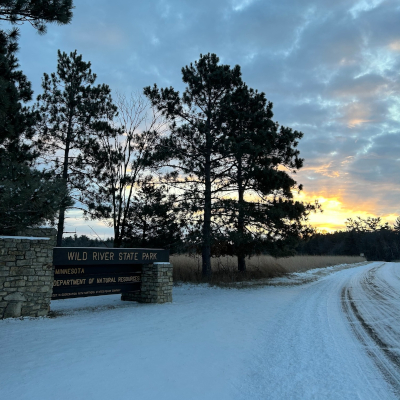 Morning activities
Morning activities
- Stop at the park office to pick up a map and get an update on trail conditions or recent wildlife sightings.
- park at the trail center and hit the trails by cross-country skiing, snowshoeing or hiking. You can bring your own equipment or rent skis and snowshoes at the trail center.
Hiking and snowshoeing At Wild River State Park
A great trail for beginners is the River Terrace Loop. Park at the lot nearest the trail, and hike/snowshoe in a counter-clockwise direction through forest and along the St. Croix River. Note: hiking and snowshoeing are not allowed on groomed ski trails.
- Stop at the Old Nevers Dam interpretive exhibit to learn about the lumber industry in Minnesota.
- Look for trumpeter swans in open sections of the river as you continue along the trail.
Cross-country skiing
- Beginners can try the River Trail and Old Logging Trail as a loop, starting from the visitor center.
- Skiers age 16 and older must carry a signed ski pass on all groomed state park ski trails. Daily passes are available for sale at the park office.
- The River Trail runs along the St. Croix River and is a great place to spot trumpeter swans.
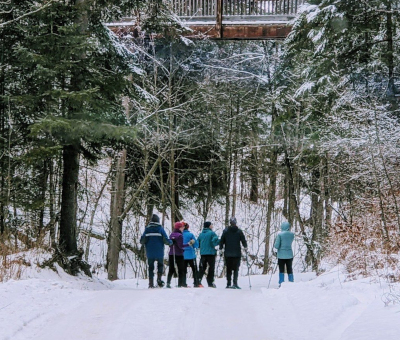 Afternoon activities
Afternoon activities
After spending the morning on the trails, stop at the visitor center to warm up and learn more about Wild River State Park. The visitor center has:
- Interpretive exhibits and displays.
- A bird watching area.
- A large deck overlooking the St. Croix River Valley.
Getting to the park
Wild River State Park is located just an hour north of the Minneapolis/St. Paul area, along the St. Croix River. From I-35, take State Highway 95 to County Road 12. Drive 3 miles on County Road 12 to the park entrance.
Special notes
- Do not rely on a GPS unit to find the park’s main entrance! GPS units direct you to the geographic center of the park (Sunrise Landing area), not to the main park entrance. Please consult a map or call the office if you need additional driving directions.
Now that you’re a fan of the parks in the winter, plan a trip to come see how they change through the seasons!

